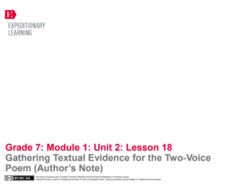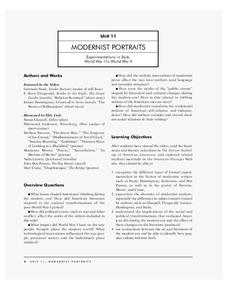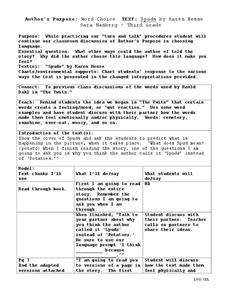Curated OER
Using Each Trait to Improve Student Writing
Students study examples of each trait in literature. They discuss how each trait adds to the craft of writing and practice revision of a writing piece with a particular trait in focus. They rate their writing on the trait of Ideas using...
Curated OER
Characterization Lessons for Middle School Students
Students learn characterization by writing about a special person in their life.
Curated OER
Writing Worksheets Can Help Students Organize Their Thoughts
Teachers can help their students organize their ideas with the use of writing worksheets.
Curated OER
Springfield Wiki Lesson - Literature Circles
Using a variety of novels about survival, such as Julie of the Wolves by Jean Craighead George, pupils create author's studies using wikis. First, learners are placed in groups to study a particular novel. Then, they create a page...
Curated OER
Sincerely Yours
Learners write a friendly letter. They write a friendly letter to author, Cynthia Rylant, after reading a number of her books, and watch a presentation by the teacher that describes how to write the letter. They word process their...
Curated OER
Cold War Conflict in Vietnam: The Vietnam-Era Presidency
Comparing and evaluating various media types is a great way to build critical analysis skills. Learners read about the Vietnam era presidency, specifically the foreign policy established by Johnson and Nixon. Then they compare several...
Curated OER
A Day of Infamy:Analyzing FDR’s Pearl Harbor Address
In 1941 FDR spoke out on the events at Pearl Harbor. The class will get to analyze word choice, word meaning, author's craft and structure by analyzing an actual draft of this speech. They will look critically at the words used,...
EngageNY
Mid-Unit 2 Assessment: Analyzing Narrative Structure and Author’s Craft: Part 1
Using the resource, scholars complete a mid-unit assessment to gauge their learning at the halfway point of the unit. Pupils read the myth "The Harvest That Never Came" and plot its narrative structure.
EngageNY
Gathering Textual Evidence for the Two-Voice Poem (Author’s Note)
Writers take a look at how to gather evidence from the information text in the unit that connects to Salva and Nya’s story. They complete a Gathering Evidence from Informational Texts sheet to guide their work. Pupils then use the...
EngageNY
Identifying Author’s Opinion and Evidence: The Value of Sports in People’s Lives, Part I
Just like instant replay, it's time to take a closer look! Pupils work together to add ideas to a Close Readers Do These Things anchor chart. They then put their knowledge to the test as they read an informational article about the...
Curated OER
Lesson: Storyboarding Revolution
Kids consider revolution as a basis for creativity, art, and storytelling. After reading an excerpt from the book, Persepolis, learners choose one event from any world revolution to write about. They storyboard the event focusing on...
Star Wars in the Classroom
"Shakespeare and Star Wars": Lesson Plan Day 1
"Now is the summer of our happiness/Made winter by this sudden, fierce attack!" Luke Skywalker meets Hamlet in a 10-lesson plan unit based on Ian Doescher's William Shakespeare's Star Wars: Verily, a New Hope. Using Star Wars® as source...
Annenberg Foundation
Modernist Portraits
How did literature reflect people's attitudes in post-World War I America? A lesson explores the topic using a variety of activities. Individuals watch and respond to a video; read author biographies and engage in discussion; write...
Annenberg Foundation
Poetry of Liberation
How do writers use words to protest injustice, challenge the status quo, and shape their own identities? Individuals watch and discuss a video, read author biographies, write poetry and journals, develop a slideshow, and complete a...
American Physiological Society
Sticky Adaptations A Lesson on Natural Selection
Now you see it, now you don't! The stick bug exhibits the ability to disappear into a wooded environment. Why does this adaptation manifest in some species, but not in others? Life science high schoolers explore animal adaptations in...
Curated OER
It's About the Author
Students develop print awareness. In this literature lesson plan, students memorize and recite nursery rhymes and listen to stories of Maurice Sendak and Ezra Jack Keats. Students draw pictures to illustrate read aloud books and dictate...
Curated OER
Author Study - Mo Willems
Students listen to books written by Mo Willems each day and discuss the story elements of each. In this reading strategies lesson, students decide after reading through the whole series of books, what their favorite book is and why.
Curated OER
Everyone is an Author!
Second graders research authors of 2 different writing styles and then write their own piece in the style they choose. In this writing lesson plan, 2nd graders look through many books for love of reading.
Curated OER
Author Study of Patricia Polacco's Family Stories
Students describe factors that influence relationships with family and friends.
Curated OER
American Government: Student Sources
In this student sources activity, students locate 3 sources regarding American government and then record the key points from each source on the provided graphic organizer.
Curated OER
Studying and Working: The Busy Lives of Students With Paid Employment
Students investigate the effect of paid employment on academic performance. They examine how to construct a survey on time use.
Curated OER
Word Purpose
Third graders chunk text while reading it. For this language arts lesson, 3rd graders determine the author's purpose for calling certain things the names they are called like spuds for potatoes. Students discuss how words affect the...
Curated OER
Once Upon a Thank You
Students are encouraged to revisit their favorite books and recall just what it was about the author who wrote each book or the characters they created that made the story so special. They then celebrate their chosen authors and/or...
Curated OER
Women Writers and Dissent in 20th and 21st Century American Literature
Tenth graders read examples of writings by women authors showing their dissent. After completion of their reading, they brainstorm on why they believe female authors have criticized society. In groups, they use the Internet to research...

























